How to create a beautiful mini meadow garden
Do you fancy a mini meadow garden?
People are increasingly interested in allowing part of their lawn to grow wild, because it looks beautiful and can help wildlife. It’s now over ten years since people were first entranced by the meadow gardens at the 2012 London Olympics. And with the launch of No Mow May, five years ago, there’s increasing interest in natural-looking meadow lawns.
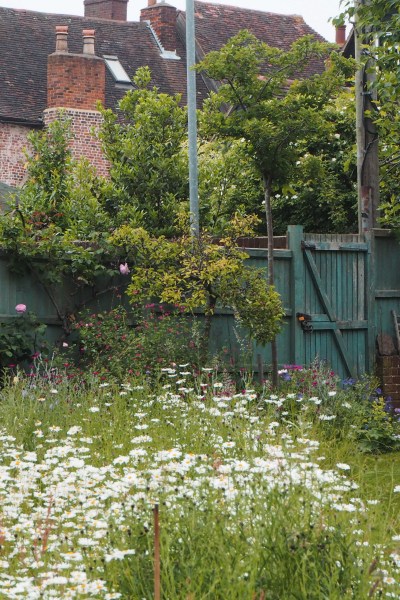
Amanda and Julian Mannering’s town garden has a meadow in the centre, measuring about 30ft x 30ft square.
Unlike the London Olympics, a middle-sized garden doesn’t have half a mile to fill with meadow flowers and native grasses. So is a mini meadow viable?
If you’d rather see a video than read a blog post, see the mini meadow video version of this on YouTube.
Amanda and Julian Mannering have a square walled garden behind their terraced house (open at the end of June every year for Faversham Open Gardens & Garden Market Day). It’s about 50ft x 60ft – space for borders all round, but not quite enough space to break up in any other way. They had a standard square lawn in the middle, but they weren’t entirely happy with it.
One day a friend stood in the middle and asked ‘what’s this lawn for?’
A meadow garden breaks up the space
So Julian and Amanda decided to turn the middle of the lawn into a mini meadow.
At first, they just mowed out the shape (around 30ft x 30ft square), with a path diagonally through the middle. Then they simply stopped mowing that area.
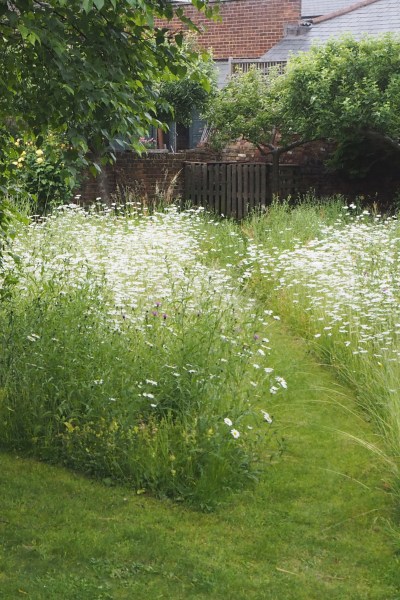
The mini meadow breaks up the space in the centre of the garden, and is wonderful for wildlife.
Friends told them that would never work, and that they would have to remove the turf.
If you are someone who likes to do things properly, then a mini-meadow does take time and preparation. Consult the RHS or buy a book such as Making a Wildflower Meadow by Pam Lewis or Meadows at Great Dixter and Beyond by Christopher Lloyd and Fergus Garrett.
(Links to Amazon are affiliate links, see disclosure.)
Or you can just let the grass grow…
But I have about half a dozen friends with mini meadow gardens. None of them ‘did it properly.’ They all just let the grass grow. But it’s worth knowing that these are all perennial meadows. An annual meadow (see later on in this post) would need the soil to be cleared.
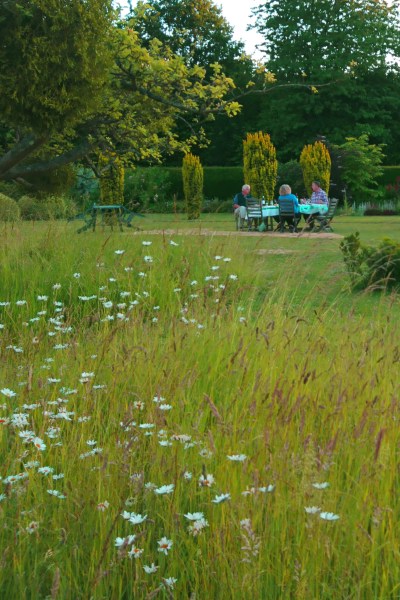
Artist Helen Kirwan just let her meadow grow out of lawn, mainly to reduce the upkeep of the garden.
When conceptual artist Helen Kirwan let her lawn grow long, she never added seeds or plug plants. Ox-eye daisies ‘came from nowhere,’ she says.
However Amanda and Julian did do some meadow planting over the years: ‘We added some wildflower seeds from Emorsgate Seeds, and watched it all grow up.’ Emorsgate Seeds sell a variety of different meadow seeds for various soil types.
The first year Amanda and Julian mainly saw cowslips and wild carrot emerge, but a wildflower meadow changes every year. The wild carrot seems to have almost disappeared.
You still have to weed a mini meadow garden
Some weeds are very invasive, such as medick, docks, thistles and dandelions.
You will have to weed them out of your meadow garden regularly or they will take over.
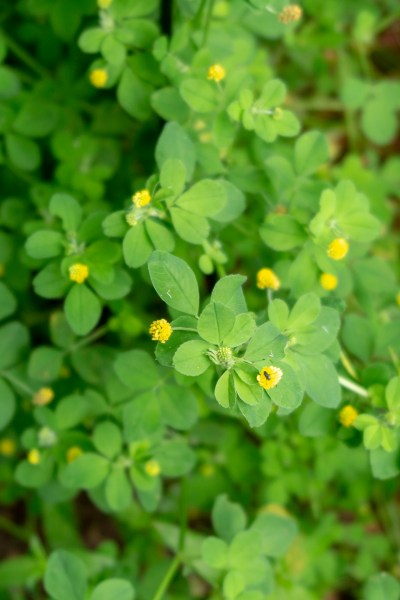
Medick spreads everywhere and stifles other plants. It seems particularly prevalent this year. You have to weed it out of meadow gardens.
Sow yellow rattle to weaken the grass
In the second year, Amanda and Julian sowed yellow rattle to weaken the grass, and this has proved to be very good advice. (They should really have sown it in the first year, but luckily nature doesn’t read instructions…)
Sarah Raven says that ‘sowing yellow rattle is the key to a mini meadow.’ That’s because it’s a parasitic plant, and will help reduce the amount of lawn grass you have. More wildflowers can establish themselves in the gaps.
A friend recently asked me why her own mini-meadow seemed to be flopping over with flattened grass. She too had simply allowed lawn turf to grow long. It was too thick and rich. I advised her to add yellow rattle to thin it out.
Joel Ashton specialises in installing wildlife friendly and eco friendly gardens. He says that traditional lawns are often too rich and vigorous like my friend’s lawn. The meadow flowers will struggle to get established in the luscious grass. He recommends planting 9cm plug plants rather than sowing seeds or planting seedlings. If you’ve been struggling to create a patch of mini meadow lawn, then see this post on common meadow lawn mistakes.
Add flowers as well as letting them grow
Amanda’s sister-in-law also gave her half a dozen ox-eye daisies (Leucanthemum vulgare) from her own meadow lawn. These have since multiplied into thousands.
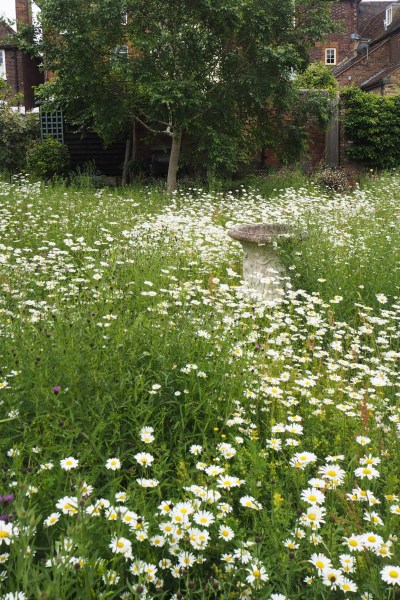
Half a dozen ox-eye daisy plants turned into this – in just two years.
You can get 25 plug plants online from Kiss-my-Grass (Boston Seeds) for £29.50+ delivery.
Amanda and Julian also sowed wild grass seeds, too, to make the original grass more diverse.
So is a meadow garden less work?
Julian and Amanda spend much less time mowing the lawn. ‘It takes about twenty minutes to mow the paths once a week,’ said Amanda. That’s much less time than they spent mowing when the whole garden was a traditional lawn.
But there’s also the weeding, plus – in the early days only – some planting of seeds or appropriate meadow plants.
And they scythe it once a year, usually some time between mid-July and mid-August. ‘We went on a scything course. It takes about half an hour to do, and it’s all fairly easy once you know how. Then you remove the scythed material – don’t leave it lying on the ground or it will add nutrients.’
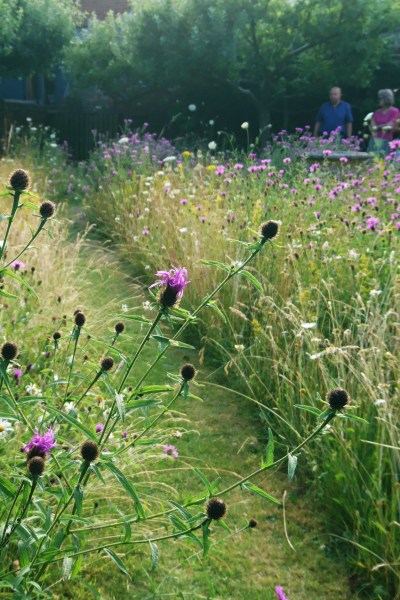
This photo of the Mannerings’ garden was taken exactly two weeks after the ones with the oxeye daisies. Complete turnaround of flowers!
‘I also rake it occasionally in the winter. Generally, it is a bit less work,’ assessed Amanda. ‘But it’s a different sort of work, and done at different times.’
Every May, there is an initiative called ‘No Mow May’. Gardeners are urged not to mow for the month of May to provide food for emerging pollinators. If you’re on social media, use the hashtag #nomowmay to share your photos and experiences. (Find me on Instagram here.)
You can also do a partial mini meadow lawn simply by mowing less often. This is called a ‘nectar lawn’ rather than a meadow lawn. Instead of mowing weekly, you mow fortnightly, so that clover, daisies and other low flowers emerge for pollinators before the next mowing. I first heard about this when I interview head gardener of the Bath Priory Hotel, Jane Moore, author of Planting for Butterflies.
She has a meadow lawn at the Bath Priory, as well as a traditional lawn. She has noticed that the longer grass of the meadow lawn withstands drought better than the traditionally mown lawn. There’s more planting for butterflies and other wildlife advice from Jane here.
Which meadow plants to choose – perennial meadow or annual meadow?
The RHS explains that you need to decide whether you are going to grow a perennial meadow, like Amanda and Julian, or an annual meadow, like my friends who sow seeds every year.
The perennial meadow needs a fairly poor soil, so don’t enrich it. Amanda and Julian’s lawn was well drained, in full sun and hadn’t been fertilised so it was ideal for a perennial meadow, which comes up year after year.
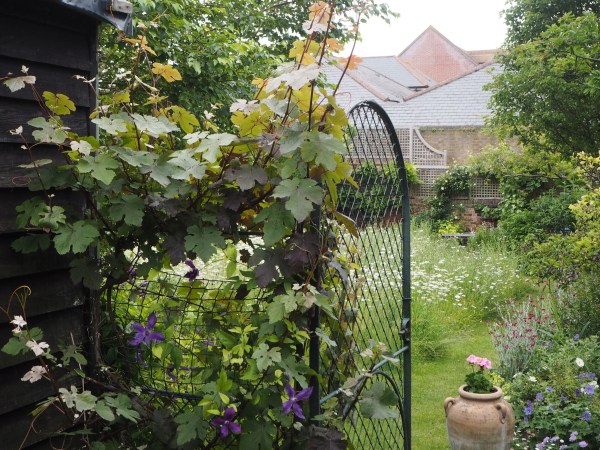
The gate into Amanda and Julian’s perennial meadow lawn, with its ox-eye daisies in June.
Perennial meadow plants include ox-eye daisies and cowslips.
Annual meadows need richer soil, so they are the right choice if you’re replacing a border with a meadow. Plants for annual meadows include cornflowers, corn poppy, corn marigold and corncockle.
Lucy Chamberlain of the Cottage Garden School posted a video of the annual meadow garden she created. ‘On March 20th we rotavated, let it settle for two weeks, sowed, then raked it in. No watering. The seed was a blend of annual poppy, cornflower, corn marigold and corn chamomile. So incredibly easy to do.’
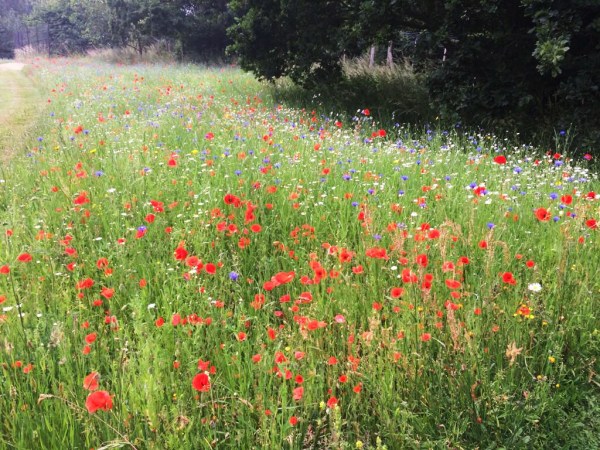
This is an annual meadow, photographed by Lucy Chamberlain. Her video of it became a Twitter success – find her as @headgardenerlc on Instagram.
Amanda has tried to establish cornflowers in her meadow lawn, but so far they’ve failed. She thinks that the slugs have eaten them, but it may be that the soil isn’t rich enough, because cornflowers grow in an annual meadow and Amanda’s is a perennial meadow.
It’s worth remembering that an annual meadow has to be replanted every year, while a perennial meadow sorts itself out (up to a point).
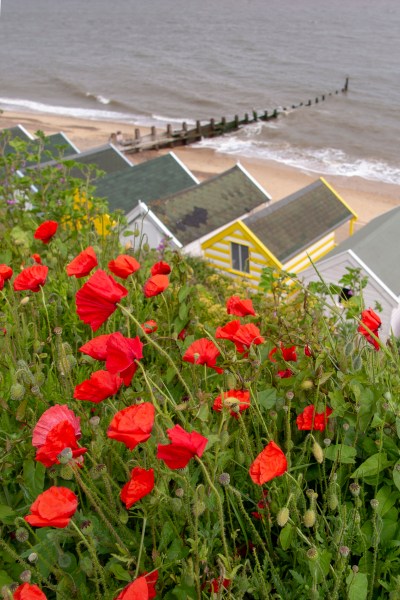
Annual poppies or Papaver rhoeas growing wild by the beach at Southwold. These are best in an annual meadow garden.
What about meadow gardens instead of flowers in borders?
Friends of mine grow wildflowers successfully in small raised beds. Former borders or raised beds are best for annual meadow plants because the soil is richer. You definitely need to start with clear, weeded soil, and an open sunny bed.
The results can be stunning – 3-4 months of changing colour, from an annual wildflower seed mix.
I hunted for annual wildflower and meadow seed mixes on Amazon. The most popular and best-reviewed was Plantworks 3 m Mini-meadow Easy Sow Wildflower Seed by Empathy. All the seeds are RHS approved ‘Perfect for Pollinators’.
And Empathy also make Rootgrow mycorrhizal fungi. This is a powder (endorsed by the RHS) which you scatter into the planting hole and which helps roots get established, improving take-up of nutrients and water. I’ve used Rootgrow on all my plantings this year, and so far everything is looking super-healthy.
Or try a ‘meadow effect border’
At BBC Gardeners World Live 2021, garden designer Tina Worboys won ‘Best Border’ for her meadow border. This was a mix of meadow flowers and cottage garden flowers that look like meadow flowers.
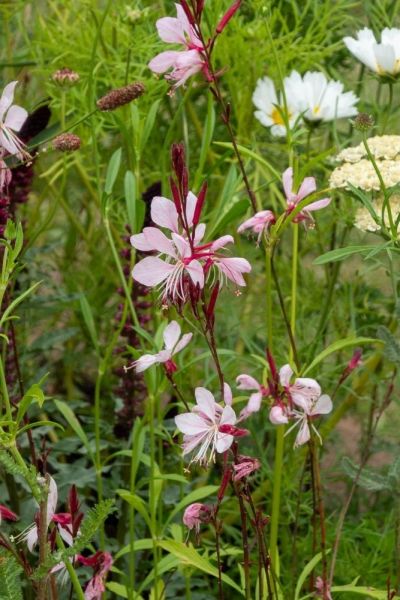
Tina Worboys’ meadow border contains a mix of meadow and border flowers, such as gaura.
For example, she had cornflowers which are meadow flowers. And she mimicked cow parsley by using ammi, a similar looking flower.
The effect was very pretty and pollinator friendly. Tina grew all the plants herself from seed.
See here for more inspiration for your garden from BBC Gardeners World Live.
Should you buy plug plants?
Plug plants get your mini wildflower meadow off to a more definite start, as you can plan which plants to put in. The ones that do well in your area will do well, and others may not.
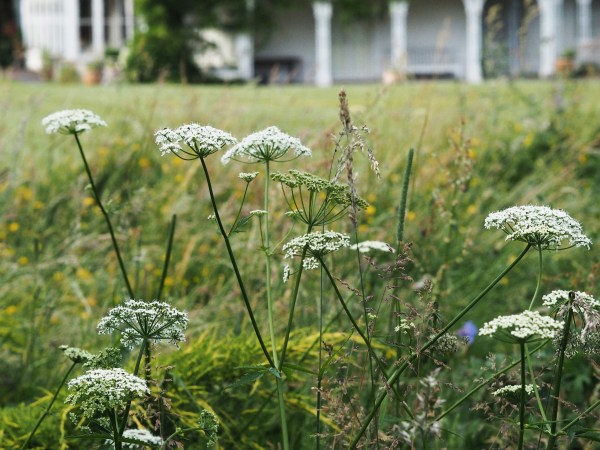
Hugh and Fiona Boucher let their lawn grass grow long, and added plug plants. Some other flowers have also seeded themselves in the meadow.
But at least the ones that do well will naturalise, so it should just be a one-off investment. Obviously, this is more expensive than seed.
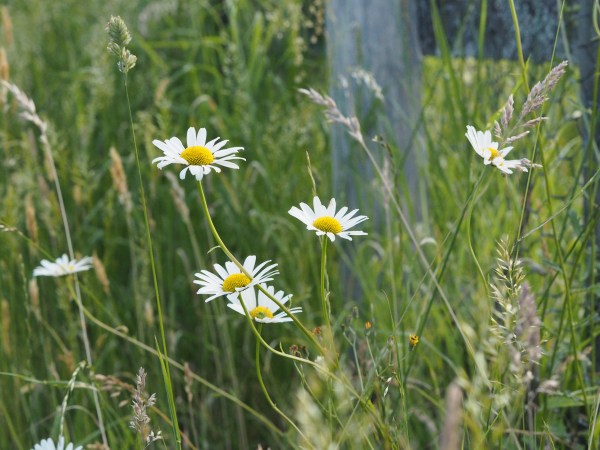
Ox-eye daisies and long grasses in the Bouchers’ meadow lawn
However, in a small area, it’s relatively inexpensive and you’ll get a more instant effect.
You can get wildflower meadow plug plants from Plugplants.net, Wildflowers.co.uk and Marshalls.
Or wildflower meadow mats?
‘Meadow turf mats’ take alot of the guesswork out of growing a meadow. I found several companies who do this, including Turf Online and Wildflower Turf,
Can you plant a mini meadow anywhere?
The key is being in full sun and having well drained soil. Very shady corners aren’t suitable for a mini wildflower meadow.
There are meadow turf mats and wildflower seed mixes which will grow in dappled shade, but you have to specifically select them. For example, The Grass People have a shaded area meadow mix. You won’t be able to grow a meadow of any size in a very shady patch.
And Meadowmat have a Woodland Shade Wildflower Turf. It’s a pre-grown mat, costing £42 a square metre, of wildflowers, and grasses that are happy to grow in partial or dappled shade.
There are also other options if you don’t want a conventional lawn.
The delightful Abbey Physic Garden is also in Faversham Open Gardens & Garden Market Day. It has just planted small sections of chamomile lawn by a new bench, and is cultivating a small patch of ‘grass-free lawn’ on the other side. There are lots of wonderful wildflower or eco-gardening ideas at the Abbey Physic and it’s a beautiful garden to visit.
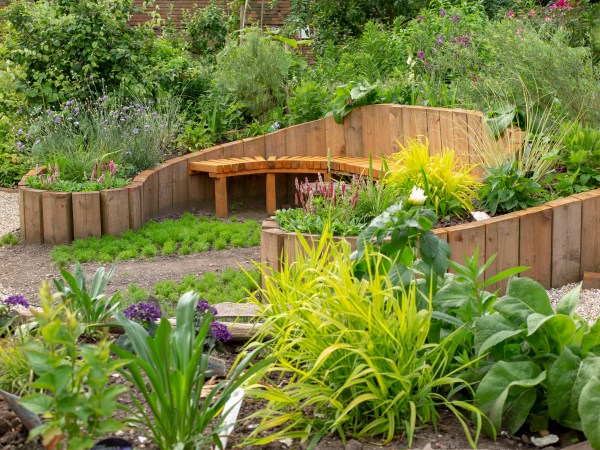
The patch of green in the middle on the left, in front of the bench, is a newly planted chamomile lawn at the Abbey Physic Garden.
But a mini meadow lawn isn’t always the best option
We have two small patches of lawn in our front garden. I decided to experiment with turning these into a mini meadow lawn.
However, I didn’t want to dig the turf up and replace it. There are colonies of ground-nesting ivy mining bees in the lawn. It makes no sense to create a wildlife habitat by digging up a wildlife habitat.
So my only option was to let the turf grass grow. I added various bulbs which naturalise, such as wild tulips. And I threw wildflower seed into the lawn.
The wildflower seed didn’t take. As Joel Ashton explains in top meadow lawn mistakes, most turf grass is too vigorous. Simply throwing a load of wildflower seed into it is pointless. It will never get the chance to germinate and flourish.
The longer grass with bulbs looked in pretty in spring. In late spring, some lovely oxeye daisies appeared in the second year.
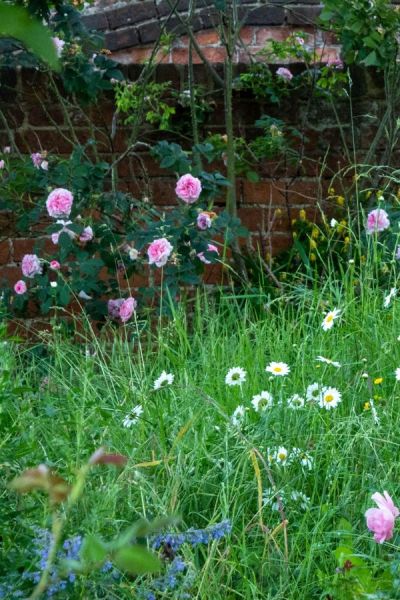
Our mini meadow front lawn looks very pretty in spring and early summer, with bulbs and oxeye daisies contrasting nicely with the roses that were already there.
But it was less successful later on in summer. And in September, when the ivy mining bees emerge from the ground, it seemed as if there were far fewer than usual.
When I visited Great Dixter Gardens and spoke to their ecologist, I discovered why. Ivy mining bees need short grass to give them access to the soil! As Fergus Garrett of Great Dixter says in Gardening for Biodiversity, both short lawns and longer lawns can be helpful to wildlife. ‘Diversity is the key to biodiversity.’
I think there’s a danger that short lawns are perhaps being too criticised at the moment. Read Do You Need a Perfect Lawn? to help you decide which lawn is best for you.
Now we keep our front garden as a spring meadow lawn, but keep it short from mid-summer onwards.
More about wildlife and eco-friendly small gardens:
If you’re interested in sustainable gardening, then I can recommend Charles Dowding’s books and videos on organic, no dig garden. Read this to find out why it is an easy, weed-free and brilliant way of gardening.
And read this to discover a way of controlling weeds in borders without chemicals. This has useful resources if you’d like to know more about what makes a good wildlife garden.
And read this if you’d like to try allowing more self-seeded plants to grow in your border. Although if you’re good at keeping your garden weed-free, you may want to read about self-seeded vs weeds first!
If you’re generally interested in sustainable living, and would like to know how to be more eco-friendly in your garden, then here is a useful sustainable garden checklist.
And water is essential in a wildlife-friendly garden. Even if you only have a small garden, consider making a mini pond out of an oak barrel or bucket.
There’s more advice on creating a container pond here – it’s a long thin pond made out of a second-hand agricultural water trough.
I also recommend the New Wild Garden by Ian Hodgson if you’re interested in naturalistic styles of planting and pollinator-friendly plants. It recommends a wide range of plants suitable for smaller gardens with guidance on how to plant and look after them.
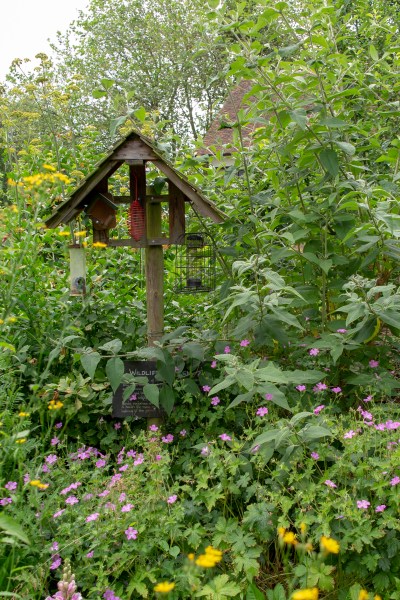
Wildflower and wildlife patch in the Abbey Physic Garden
Faversham Open Gardens & Garden Market Day is the last Sunday in June
Amanda and Julian’s meadow garden and the Abbey Physic Garden are open for Faversham Open Gardens & Garden Market Day which is held on the last Sunday in June every year.
Shop here for my favourite gardening books, tools and products
While I wouldn’t always describe myself as an organic gardener, I try to garden in a sustainable and wildlife friendly way. And when I created the Middlesized Garden t-shirts, hoodies and tote bags, I linked up with Teemill. That’s because they create print-on-demand products, so there’s no waste. And they use natural materials, manufactured with renewable energy and deliver in plastic free packaging. I love the style and fit too. Check them out at the Middlesized Garden Teemill store.
I’m often asked for recommendations. What tools should you buy? What’s a good gardening book to give a friend? How can you minimise the use of single use plastics in the garden?
So I’ve put together some lists of products I use myself and have found good, and you can find them on The Middlesized Garden’s Amazon store.
Pin to remember mini meadow tips:
And do join us every Sunday morning for gardening tips, ideas and inspiration. See here to follow by email.
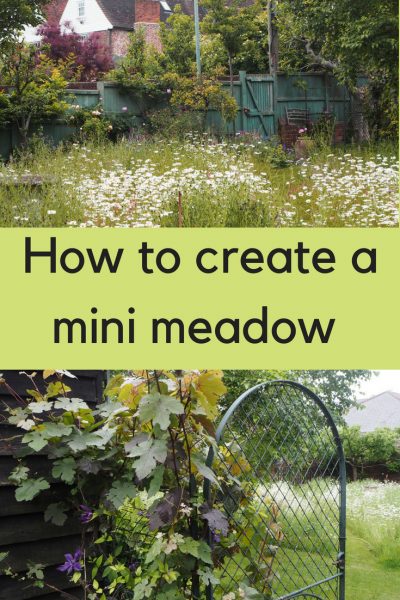
























Would the yellow rattle destroy ornamental grass? There a patch in my garden I’d like to try a perennial meadow but on the edge is a grass (wish I could remember the name now!) I’m assuming yes but can I leave a gap between them? or a plant barrier? Many thanks
If you’re mowing your lawn regularly, the yellow rattle is unlikely to get established, because it’ll never get tall enough to flower and reproduce. You might occasionally have to weed the odd plant out, but so far I haven’t heard of people having problems. I’m not sure that a barrier would help as seeds are blown in the air or carried by birds, neither of which would be prevented by a barrier. Hope that helps!
About April years ago I planted about 20 snakes head fritillaries in my lawn next to my pond in the front garden. I wanted them to seed so didn’t mow my grass until the seed heads were dry and then I scattered the seeds. It does look untidy, the grass gets long and other plants have moved in. The spotted orchids are a real bonus, the dandelions get weeded out. Froglets have somewhere to shelter. I do mow in the autumn and remove the clippings. It has been a pleasure to see my damp meadow develop.
That sounds beautiful.
Just wondering if there are any laws for outside city limits for planting pathed garedens> I have a wildflower garden i am working on one side of our hay field, I regsieted it with three diffeerent certifiaction pollnator web sites puts signs up and no tresspassing signs up because it is a registerd pollinator garden and some people don’t like what I am doing for jeolousy reasons ..they want it unblocked for trails use and hunting ..i said nope you can’t use my land so they want to try to block with fraud attempts of blocking my lawn mower pathed garden!Would i have the right to sue and they can not legally threaten my garden rights!
I hope they get a law like they did for hunters ..No harssassment or threatenning any gardeners or blocking thier legal gardening rights of other people trying to protect and helping wildlife and pollinators as long as they are abiding the laws of thier state!Right!?it is only fair!
They wouldn’t do that for our protecetd gardens and parks ect… So they should have a law for personal garden privacy and proetction lawI hope our ledars will give us that protection or hire fines for people doing damage or jeoaluousy attempts to property they have no right to be on!
Laws and regulations are very different in different places, and sometimes there can be extra regulations attached to a particular area even within a county or state. (for example, a new housing estate built with certain conditions attached, or an area becoming designated for a particular purpose). So I cant comment on the legal side of anything – a local lawyer or council officer may be able to clarify the situation. Good luck!
Thank you so much Alexandra. This is exactly the practical advice I was looking for. We’ve just moved into a new house with a large lawn and I’m so excited to let it grow and see what flowers come. I will also follow the excellent examples given and get some plugs and yellow rattle
Thanks again for all the time you’ve put into your blog and YouTube videos – they are invaluable to me and will hopefully help me make my middle sized garden as nice as yours
Thank you so much, that’s lovely to hear.
Great article, very informative – thanks for taking the time to write it.
Your videos and blog will be a handy place for us, with an acre of overgrown but landscaped garden. One thing that is not addressed here (or anywhere else for that matter) is the maintenance and detail associated with a path in a wild meadow garden. The grasses that withstand foot traffic are not the same as those in the meadow. There are pictures abound of wildflowers next to paths, but nobody seems to have any information on how the two should be established side by side. What steps should one take to establish main paths alongside establishing wild areas, from bare soil? Your friend’s garden looks to do it very well, but how…?
The garden in this post belongs to good friends of mine, so I can confirm that they simply mowed a path through their meadow and they didn’t plant a different grass for the footpaths. However, this is a private garden, so the amount of foot traffic they get isn’t great. I think the explanation would be that they had an ordinary lawned area. They allowed the ordinary lawn to grow up as a meadow, mowing a path through it. This path is mown frequently throughout the spring and summer. So the mown grass paths stayed very much as lawn grass always is, and therefore was able to withstand footfall just as an ordinary lawn is. However, the wildflower area of the lawn has slowly become more wildflowers and less lawn grass, especially as yellow rattle, which weakens lawn grass was planted in it. So the two grasses probably are different now, but the gardener didn’t need to plant different grasses. If, however, you have a completely empty area, without any grass at all, I think commonsense would suggest using lawn turf (preferably one of the resilient varieties) for the pathways and then planting up the rest of the area with meadow flowers and grasses. I hope that helps.
Hi our garden has a septic tank and drain field which limits what we can grow and where. Its covered by lawn, could I grow a wild flower meadow over the grass? Was thinking of growing a few giant oat grass plants just to add height to break up the garden. Are they shallow rooted?
I’m sure that a wildflower meadow would be fine with a septic tank and drain field as the roots are very shallow, but just to make sure, why not check with the septic tank installers or manufacturers? My understanding is that problems are caused in areas with septic tanks by plants with extensive roots, such as trees and large shrubs or water loving plants that may grow too much. But I don’t personally have a septic tank, so that’s only my opinion. However, I’ve found this article from Clemson University in South Carolina that looks helpful and it suggests that oat grass is suitable. There is a listing of suitable plants, including wildflowers and bulbs. Hope that helps: https://hgic.clemson.edu/factsheet/landscaping-over-septic-drain-fields/
I’d be really interested to know your thoughts on this …
I have a brand-new parterre. It’s very small – just 4 beds of about 1m2 each, no box hedge or anything similar – just bed butting up to brick edging. I was thinking of planting each with annual wildflowers this year. However, it’s right outside the back of the house, so in view all year round, and I was considering putting some perennial grasses – something like a Panicum virgatum heavy metal, and sowing the annuals around them – that way I’d have interest going into the autumn/winter. I’m worried that the result will just be ‘messy’ – do you think this would work?
I think that it would be worth experimenting. As the panicum and the annual meadow flowers don’t overlap for very long, I don’t personally think it would be messy. Friends of mine who have sown smallish blocks of meadow in raised beds have enjoyed about three to four months of ever-changing colour (they use mixed annual meadow seed packs) It all dies down around September ish, while my panicum is at full height from August to when I cut it down in March. It actually sounds as if you have a wonderful idea there, so why not just see what it looks like and change it the following year if it doesn’t work. If the meadow annuals don’t work with the perennial grasses you can add in other meadow-style perennials (echinacea, rudbeckia, ox-eye daisies). You can extend the season by adding in crocus, snowdrops, cyclamen, wild (species) tulips, primroses, snakes head fritillary, etc. The only thing to keep an eye on is that many perennial meadow plants thrive in poor soil while annual meadows like rich soil. Good luck, personally I think it’s a brilliant idea so keep tweaking if it doesn’t work!
Some delightful ideas.
thank you!
NIce article. Love meadow planting. We have to remember dandelions are invaluable for the bees at the end of winter/early spring. Unfortunately, oxeye daisies (which I love) are banned as noxious weeds here in Australia.
a good point about dandelions, and interesting to hear about oxeye daisies…